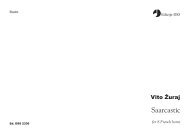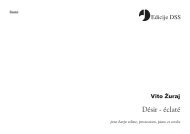Vito Žuraj - Begehren - zersplittert
for harp solo, percussion and strings ©2020 by Edicije DSS
for harp solo, percussion and strings
©2020 by Edicije DSS
- No tags were found...
You also want an ePaper? Increase the reach of your titles
YUMPU automatically turns print PDFs into web optimized ePapers that Google loves.
General remarks<br />
Transposing score.<br />
All notes should be played non vibrato unless indicated otherwise.<br />
All notes in this piece marked tenuto (especially those with a crescendo) and followed by a rest, should be<br />
performed over their exact rhythmic duration.<br />
All notes in this piece marked staccato should be extremely short. The lengths of such notes should<br />
remain uniform throughout the piece, irrespective of whether they be quarter-notes, eighth-notes,<br />
sixteenth-notes or other note values.<br />
Explanation of general articulation symbols<br />
two or three very short repetitions of the indicated pitch<br />
portamento: up to a minor third upward / downward, starting from the written pitch<br />
tremolo for strings, percussion and keyboard; flutter tongue for woodwinds and brass; to be executed<br />
as rapidly as possible<br />
Notation for harp<br />
Playing with screwdriver<br />
Grip the handle of screwdriver and put the metal shank between two indicated neighbouring strings as<br />
shown below. Execute a chain of tapping actions, continuously producing a tap on the first ( ) and the<br />
second ( ) of the two neighbouring strings alternately, unless indicated otherwise: A sound with<br />
clear pitch refence should be produced by this action, without any plucking. A special clef is used to<br />
indicate the screwdriver‘s approximate position along the strings. The middle line indicates the half of the<br />
string length:<br />
position of the<br />
metal shank<br />
along the string<br />
strings<br />
to be tapped<br />
(in the box)<br />
The notated pitch corresponds to<br />
the contact-point of the screwdriver<br />
on the string and does not represent<br />
the contour of the sounding pitch!<br />
damp strings between<br />
screwdriver and pedal discs<br />
play with screwdriver in<br />
right hand, metal shank has<br />
contact with the string<br />
L<br />
contact-point<br />
Metal shank<br />
laissez vibrer - no damping<br />
l.v.<br />
Pedal buzzing<br />
Arrange the B-pedal into the ∫-position, the A-pedal to the point of slightly above the #-position and pluck<br />
the two indicated strings simultaneously as loud as possible. As thus the buzzing on the A-string starts<br />
immediately but softly if possible. Move the A-pedal as slowly as possible towards the \-position (without<br />
actually reaching it) which should result in buzzing volume gradually ascending and, after reaching the peak,<br />
slowly fading away. Just after the buzzing volume on the A-string has reached the peak, add the buzzing<br />
on the B-string with the motion of the B-pedal as slowly as possible from the point of slightly below the<br />
∫-position towards the \-position (without actually reaching it), starting softly if possible, gradually getting<br />
louder and subsequently fading away. As thus the buzzing on the A- and B-strings should be merged together<br />
into a single, long buzzing action, preserving the B∫-pitch as clearly as possible. This action requires delicate<br />
judgement by the player and may vary significantly from one instrument type to another.<br />
Pitch bend (wobble)<br />
After plucking the string with left hand, produce a wobble with the thumb of right hand on the indicated<br />
string between the upper part of pedal switch and tuning pins.This action requires the according pedal being<br />
arranged into the ∫-position.


















